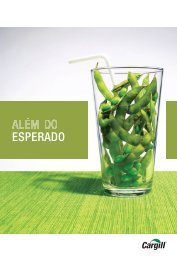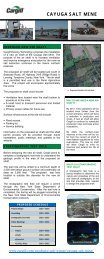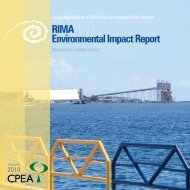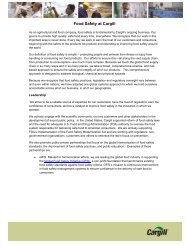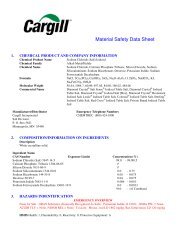Cargill News September-October 2007
Cargill News September-October 2007
Cargill News September-October 2007
You also want an ePaper? Increase the reach of your titles
YUMPU automatically turns print PDFs into web optimized ePapers that Google loves.
LEFT: “Muster” begins at 5:15 in the morning, just as the sun is beginning toappear on the horizon. Employees assembled on a soccer field with shoutsof “pagi!” (“good morning” in Indonesian). Some bring children to drop offat school. Today, managers lead a safety discussion about someone whowas almost hit by an empty drum yesterday. “We want you to go home unhurtand healthy,” says Cahyo Nugroho, manager of Environment, Healthand Safety.BELOW: <strong>Cargill</strong> provides full safety gear for herbicide applicators, and ifemployees forget the gear, they are sent home. The job of the all-femalecrews is important. Keeping a circle free of vegetation under a tree keepspoisonous snakes away from the harvesting area.A harvester wheelspalm fruit bunchescalled janjangs to theroad for collection.Records are kept ofthe output of eachharvester so individualscan earn bonusesfor hard work.<strong>September</strong>-<strong>October</strong> <strong>2007</strong> CARGILL NEWS 2125587.indd 218/29/07 10:54:15 PM
FFI has worked for years to protect the orangutan in Indonesiannational parks. They organized a forest patrol oflocal tribesman that has dramatically reduced illegal loggingin Gunang Palung National Park. (See “Guardians of the Forest”on page 27.)Momberg rates <strong>Cargill</strong> as being among the leading plantationowners on sustainability issues. “<strong>Cargill</strong> is one of thefew plantation developers with an NGO partnership,” hesays. “Palm plantations offer a sensible alternative for degradedland. They can improve the land while providing economicbenefits to the local people.”FFI, the world’s oldest conservation organization, hastaken a stance of working with industry. “We believe thatgreat returns to conservation can be achieved by workingin partnership with business on responsible business practices,”Momberg says.Out of the blocksAt the Harapan plantation, the palm trees are planted asregularly as corn stalks—just a lot bigger, taller and shadierthan more typical agricultural crops. Each trunk shows thecross-hatched pattern of fronds that are pruned as the treegrows taller. The bunches of oilseed fruitlets grow at the topof the tree, just above the lowest fronds. Cutting the lowestfronds is part of freeing the fruit bunch.So each year the tree grows taller. Oil palms, a tree thatoriginated in Africa, are most productive between five and25 years. As the trees mature, ferns and bromeliads populatethe pockets in the cross-hatched bark, so the whole treelooks like a mass of vegetation.Driving the dirt roads from the green blocks of treestakes you into very different terrain. Degraded land isdominated by imperata grass, a scattering of bushes andsome stunted trees.“Imperata grass comes in after a fire and is adapted tolow soil fertility,” explains agronomist Fairhurst. “Once yousee this grass, the land will never go back to forest.”Getting out of the truck, he digs into the soil. “Look, thesoil is gone,” he says. “There’s less than 5 centimeters oftopsoil here. By planting oil palm, we can transform a desertinto a productive ecosystem.”The alternative—leaving degraded land undeveloped—sets up the perfect conditions for wild fires.“The land we are looking at for expansion was all previouslyburned out, eroded or subjected to logging or slashand-burnfarming,” Fairhurst says. “Degraded land is by farthe best way to produce vegetable oil.”When planted on degraded land, palm plantations can sequestercarbon and reduce greenhouse gases. Cutting foreststo plant palm, by contrast, is a net contributor to greenhousegas production.“Palm plantations can be a plus for reducing the carbonfootprint,” says the FFI’s Momberg. “But only if they areplanted on degraded land.”22 CARGILL NEWS <strong>September</strong>-<strong>October</strong> <strong>2007</strong>25587.indd 228/29/07 10:54:30 PM
Safety FirstEach day, harvesters begin their work with asafety demonstration. There is a reason that<strong>Cargill</strong> has been recognized by the Indonesiangovernment with an award for promotingworkplace safety.The demonstration starts when a memberof the crew is chosen to show the proper wayto trim palm fronds and cut the fruit bunch.The supervisor’s critique includes a lot ofcompliments for doing things right. The restof the crew is drawn in with questions on whyit is important to do things this way.Typically, the frond under the fruit bunchmust be cut away to get at the fruit. Thenthe fruit bunch, which can weigh 40 kg. (80pounds), is cut. Hard hats would not protectemployees from heavy fruit bunches crashingto the ground, which is why the cutting techniqueis so important.One lesson today is mengaruk pingiran—cleaning the circle. The harvester must clearfallen fronds away from the circle around thetree to avoid tripping over them. The frondsare stacked around the perimeter to providea mulch cover and soil fertilization.“Harvesting requires the right techniquealong with great strength,” explains Rob Nicholls,senior estate manager. “I’m twice the sizeof some of these men, and I struggle with it.Sometimes they ask me to do the safety demonstrationso they can have a good laugh.”Harvesting on a palm plantation is aconstant process. A palm tree averages 12bunches of fruit a year. Each block in an estateis walked every 10 days to spot ripe fruitbunches.Following the demonstration, the wholecrew breaks into applause. The honored employeereceives an embrace from supervisorAdam Silvanus (inset).With shouts of “good morning,” the harvestersdisperse to do their work. It’s 6 a.m.,and the real heat of the day won’t begin for acouple hours.<strong>September</strong>-<strong>October</strong> <strong>2007</strong> CARGILL NEWS 2325587.indd 238/29/07 10:54:34 PM
A communityPalm plantations are a lot more than vegetation. There is a majorpeople component to a business that has thousands of directemployees and family members living on the property. At Harapan,most of the employees come from the nearby island of Java,one of the most overpopulated places on earth.“There is a lot of unemployment on Java,” said Rob Nicholls,senior estate manager. “People tend to come here for two to fiveyears, build up their savings and return to Java to buy a houseor start a small business. We have to be very competitive withother plantations.”In Indonesia, 40 percent of the population lives on lessthan $2 a day, and the minimum wage is around $80 a month.With wages and production bonuses, many plantation employeesearn about $350 a month, according to Mohan Nair, chiefoperating officer of <strong>Cargill</strong>’s plantations in Indonesia. In addi-Poet of the Rainforestohanes Terang lives at the base of a rainforest nearGunung Palung National Park on the island of Borneo.The narrow dirt road that leads to his house isn’t easyto find, but Terang has attracted a steady stream ofvisitors from around the world—from New York Timesreporters to officials of the Indonesian government.The Dayak tribesman has pioneered the idea of creatingseedling nurseries for rainforest trees. Fifteen of thefamilies in his village have taken up the effort—collectingseeds from the rainforest and nurturing the young plantsuntil they are large enough for transplant.“We just shipped 63,000 trees—six truckloads,” Terangsays, sitting on a plank floor in an empty room of his housewhere he receives visitors.The effort has created interest because it provides aneconomic alternative to logging for the Dayaks. Instead ofcutting down rainforests at the behest of rich lumber traders,they can propagate indigenous trees to restore rainforests.There also is the possibility that valuable treeslike the garu, or incense wood, could be grown as commercialtree crops—eliminating the motivation to stealthem out of the rainforest.Cahyo Nugroho, <strong>Cargill</strong>’s manager of Environment,Health and Safety at the Harapan palm plantation, sitson the floor across from Terang. With him is Frank Momberg,director of Asia program development for Fauna &Flora International (FFI). Terang received a small grantfrom FFI, which also is <strong>Cargill</strong>’s environmental partner.“I want to learn about seedling production from him,”Nugroho says. “I think we have a chance to teach villagerson our plantation about forest management. Seedlingproduction could be a community development project.”The indigenous people of Borneo, Dayaks traditionallylived off the land by hunting and slash-and-burn agriculture.As part of the land-rights settlement, Dayaksliving on <strong>Cargill</strong>’s plantation receive income from parcelsof plantation land. Some sell their shares, run out ofincome and turn to illegal logging.“A Dayak won’t give up his culture just because he getsDayak tribesman Johanes Terang (center) collects seeds of nativetrees in the forest behind his house and has started a thriving nurserybusiness for forest restoration. <strong>Cargill</strong>’s Cahyo Nugroho (left) visitedTerang along with Frank Momberg of Fauna & Flora International.two hectares of plantation land,” Momberg says. “Thebest approach is to combine environmental efforts withcommunity development. That is why Cahyo was interestedin seeing the seedling production.”Terang fetches a tattered notebook with a plastic cover. Alot of the publicity he has received is because he writes poemsabout the rainforest. In a deep, dramatic voice he begins toread a poem in Indonesian. Momberg does his best to translatewhat he describes as “Shakespearean Indonesian.”The creator has not forgotten.He observes us from above.Time and each destruction of the forestWill slowly finish it all.One by one, our connection is being cut.Terang has testified before government committees,using his poetry to convey the emotion he feels. “We areseeing flooding and prolonged dry periods because of theillegal logging,” he explains. “Since I was a child, I feltclose to nature. I would never leave this place.”At the end of the visit, Terang smiles and pulls out aragged guest book for the visitors to sign. It contains hundredsof names and inscriptions.24 CARGILL NEWS <strong>September</strong>-<strong>October</strong> <strong>2007</strong>25587.indd 248/29/07 10:54:48 PM
tion, employees get free housing, healthcare, schooling for their children, a riceallowance and other services.Some employees invest in trucks andrent them to the plantation. Others openrestaurants or buy a 2-hectare “coupling”of palm plantation—land that allowsthem to collect rent and a royalty on fruitharvested from the coupling. In mostcases, both parents work on the plantation,making use of free day care to earnmore family income.Raising incomes is one key to solvingenvironmental problems, Nair believes.“If we can provide people with steadyincomes, they will stop cutting forests,”he says.At Harapan, 20 percent of the plantationis owned by smallholders. Most arelocal Dayak tribesmen who live in villageson the plantation. They negotiatedshares in exchange for their traditionalland rights. A 2-hectare share is enoughto provide a monthly income of 3 millionrupiah (around $300).“The villages overwhelmingly—99percent—favor development,” says DanYunan, chief development manager.“They own the land, drawing rent anda share in the oil produced. <strong>Cargill</strong> doesthe management and collects managementfees. The village gains a long-termsource of income.“As the lives of the smallholders improve,a lot of the problems will be reduced.People won’t feel that they have toTOP: Employees worship at a mosque on the<strong>Cargill</strong> plantation. <strong>Cargill</strong> donated the materialsand cash for its construction. “We need toattract people here, so the social conditionsare important,” said Johnson Sinaga, technicalservices manager.CENTER: <strong>Cargill</strong> supplies employees with freerice on the Harapan plantation. Rice is muchmore expensive in Borneo than it is in Java, thehomeland of most employees.RIGHT: Women have the prestigious job of drivingthe tractors to pick up harvested fruit.Managers have found that women are moreconscientious about handling machinery.“Males dominate society in Indonesia,” saysRob Nicholls, senior estate manager. “At first,people laughed at the idea of giving women thejob of driving tractors, but now it’s viewed asnormal.” Requiring helmets for tractor driverswas a <strong>Cargill</strong> safety innovation.<strong>September</strong>-<strong>October</strong> <strong>2007</strong> CARGILL NEWS 2525587.indd 258/29/07 10:54:52 PM
ABOVE: One of <strong>Cargill</strong>’s duties is building townships for employees and theirfamilies. Houses made of concrete are replacing the original wood houses.BELOW: Signs of increasing income aren’t hard to spot around the plantation.Many employees ride new motorcycles to work so they can go home for lunch.This restaurant called “By the Fish Pond” was started by Tujinin (many Indonesianshave a single name) and his wife. With his earnings and bonuses as a harvester,Tujinin also was able to purchase 2 hectares of plantation land, allowinghim to earn rent and payment for the fruit harvested on his land. The owner ofa 2-hectare parcel can earn up to $400 a month—big money in Indonesia.cut down timber because they’re financially desperate.”Signs of increased affluence are evident in the townof Manis Mata, just outside the plantation. As recently as2000, the town didn’t even have a restaurant. It has morethan doubled in size, boasting a jewelry store, mobilephone shops, a hardware store, clothing stores, a bankand a motorcycle shop. Cars have joined motorcycles onthe town’s streets.The palm plantation business simply has a higher levelof involvement with employees and the community thanmore typical <strong>Cargill</strong> businesses.“You have to be father, brother and doctor,” says Nair,who was general manager of Harapan for several yearsbefore moving to Singapore. “That is what the plantationbusiness is all about. You have to know a little bit abouteverything—from repairing factory equipment to orderinghospital supplies. Our hospital delivers 35 babies a year!”Nobody is saying that the issues surrounding palmplantations are easy. But the stakes are too high—bothfor the environment and for the people—to fail to addressthose issues.“We need to develop our plantations to such a highstandard that we can invite the world in to see how we doit,” Fairhurst says. “I believe that <strong>Cargill</strong> can be a pioneerin showing the industry how to really do things right.”26 CARGILL NEWS <strong>September</strong>-<strong>October</strong> <strong>2007</strong>25587.indd 268/29/07 10:55:05 PM
Guardiansof the ForestFAUNA & FLORA INTERNATIONAL IS ORGANIZINGRAINFOREST RANGERS TO PREVENT ILLEGALLOGGING AND PROTECT ORANGUTAN HABITAT.GUNUNG PALUNG NATIONAL PARKdozen Dayak tribesmen dressed in intimidating black uniformsform a circle and say a prayer before entering theforest. Prayer concluded, leader Ibrahim Sindang headsacross a rushing stream, directing his team up the mountainsideinto the rainforest of Borneo’s Gunung PalungNational Park.<strong>Cargill</strong> partner Fauna & Flora International (FFI) started thepatrol in 2003, when there were an estimated 1,000 illegal loggersin the park at any given time. “We have seen a dramatic reductionin logging,” Sindang says. “Before, they would pull logs outin front of your eyes.”The patrol not only protects the rainforest, it protects the estimated2,500 orangutans in the park that depend on the rainforestfor their habitat. The biggest tree-dwelling animals in the world,orangutans spend most of their lives in trees, bending branches tomake a nest in a new tree every night.In Malay, orangutan means “person of the forest.” It’s an aptdescription considering that the orangutan shares almost 97 percentof human DNA. But man’s close relative is in trouble. TheUnited Nations lists the orangutans of Borneo as endangered.TOP: Preparing to enter the rainforest, the OrangutanProtection and Monitoring Unit touch hands and say aprayer. ABOVE: Baby orangutans are so cute that theyare in demand as pets around Asia—at least until thestatus symbol gets too old. <strong>Cargill</strong> is working with Faunaand Flora International on strategies for orangutanprotection.<strong>September</strong>-<strong>October</strong> <strong>2007</strong> CARGILL NEWS 2725587.indd 278/29/07 10:55:22 PM
Guardians of the ForestRangers recruited and trained by Fauna & Flora Internationalpatrol the rainforest in Gunung Palung NationalPark. There are 2,500 orangutans in the park. Since thepatrols started four years ago, illegal logging has gonedown by 65 percent. The rainforest terrain provides astark contrast to the degraded lands, previously loggedor burned, where <strong>Cargill</strong> is developing palm plantations.28 CARGILL NEWS <strong>September</strong>-<strong>October</strong> <strong>2007</strong>25587.indd 288/29/07 10:55:36 PM
<strong>September</strong>-<strong>October</strong> <strong>2007</strong> CARGILL NEWS 2925587.indd 298/29/07 10:55:47 PM
Most estimates put the world population of orangutans at50,000—down from 300,000 just 20 years ago.<strong>Cargill</strong> has been caught up in the concerns about the endangeredorangutans because oil-palm plantations are often citedas a cause of habitat destruction. This charge is true for somepalm plantation developers. In fact, some developers neverplant palm trees on their concession; they just disappear withthe windfall of cash from logging.As a member of the Roundtable on Sustainable Palm Oil(RSPO), <strong>Cargill</strong> is trying to change the industry. Membersof RSPO pledge to protect High Conservation Value Forest(HCVF) on their concessions. They confine their developmentto degraded land that was logged or burned years before.FFI is working with <strong>Cargill</strong> to survey its Harapan plantationin West Kalimantan, located in the Indonesian part ofBorneo—the huge island that Indonesia shares with Malaysiaand Brunei. FFI will help <strong>Cargill</strong> identify HCVF land on itsplantation and develop an action plan for orangutan conservation.The project includes an assessment of five areas outside<strong>Cargill</strong>’s plantation that hold remnant populations oforangutans.“<strong>Cargill</strong> is one of the few palm-oil plantation ownersthat works with an NGO,” says Mohandas Nair, chiefoperating officer of <strong>Cargill</strong>’s Indonesian palm plantationbusiness. “This industry faces controversy, so that’s allthe more reason that we must do things right. We wantto set a model for responsibility.”Asri Isman is one of the rainforest rangers. He used to work with Harvardresearchers in the park before they were driven away by illegal loggers. “I lovethe forest very much,” he says.On patrolIn the rain and with nightfall coming, Sindang leads theDayak rangers on a trail blazed through the rainforest.Towering trees tend to limit the forest undergrowth.Stepping on wet rocks, Sindang climbs along the edgeof a ravine with the rumbling noise of a waterfall somewhereahead. Tonight, the team will spend the night attheir camp, sleeping on a platform made of ironwood—the only wood tough enough to stand up to the termitesof the rainforest.Sindang pauses to point out trees like the Lamin andMercantí—targets of illegal loggers. Cut and shipped toChina, the rainforest trees are turned into plywood andoutdoor furniture.“The forest was always considered sacred,” he says.“We know some of the loggers personally, and they areashamed to be discovered in the forest. We go into thevillages to talk about how people need to abandon illegallogging. We try to educate villagers on the value ofthe forest—how their irrigated rice fields depend on theforest watershed.“We are beginning to see some attitude changes. Oneillegal logger became a forest ranger. Now, he is a villagechief and is promoting conservation.”Angus Nadi, a member of the patrol—officiallycalled the Orangutan Protection and MonitoringUnit—was once an illegal logger. Impressed by theFFI and other conservationists, he applied for a jobwith FFI’s rainforest patrol. “How can outsiders takean interest in protecting our forests while we cannotdo it ourselves?” he asks.Traditionally, the Dayaks occasionally ate orangutans.The great scientist Alfred Wallace, a contemporary ofCharles Darwin, studied evolution in Indonesia and was particularlyimpressed by the Dayak tribesmen. “They are simpleand honest,” he wrote. “The moral character of the Dayaks isundoubtedly high—a statement that will seem strange to thosewho have heard of them only as headhunters.”Today, several members of the patrol sport T-shirts with theorangutan’s image. The commitment is important. What they willearn from FFI in one month, illegal loggers can earn in a week.30 CARGILL NEWS <strong>September</strong>-<strong>October</strong> <strong>2007</strong>25587.indd 308/29/07 10:55:57 PM
Frank Momberg (left), Fauna &Flora International program directorfor Asia, points out the extentof the rainforest in Gunung PalungNational Park. With him is CahyoNugroho, manager of Environment,Health and Safety at <strong>Cargill</strong>’s Harapanpalm plantation. <strong>Cargill</strong>’s plantationhas no primary rainforest,but it has stretches of High ConservationValue Forest that <strong>Cargill</strong> iscommitted to protecting.“We know some of the loggers personally, and theyare ashamed to be discovered in the forest. We gointo the villages to talk about how people need toabandon illegal logging.” IBRAHIM SINDANG leader of FFI’s orangutan protection unitWaking at dawn to the sound of gibbons hooting in the forest,the patrol members don their black uniforms, breakfaston noodles and vegetables and head off for a week of patrol.First-time offenders will be given a warning and evicted. For asecond offense, loggers will be prosecuted and their equipmentconfiscated. The patrol also destroys campsites and other infrastructureused by illegal loggers.Sustainable palmFrank Momberg, a German with a background in ecology and anthropology,organized the forest patrols as part of his work withFFI. As Asia project manager for FFI, he works with <strong>Cargill</strong> onenvironmental management systems for palm plantations.Momberg rates <strong>Cargill</strong> as being in the upper 5 percent ofpalm plantation owners for sustainable development.“Things like paying loggers to change their colors and becomeforest security people are ideas worth considering,” saysThomas Fairhurst, <strong>Cargill</strong> agricultural director for palm plantations.He and Momberg have also discussed the possible rolecarbon credits might play in providing economic incentives forpreserving rainforest.The issues are anything but simple, especially consideringthe problems in enforcing Indonesian laws in remote areas.<strong>Cargill</strong> has a clear stake in being a force to improve the situation—notjust on its own plantations but also in the industry.“Many of our customers want no association with palm oilthat comes at the expense of the destruction of rainforest ororangutans,” says Bruce Blakeman, corporate affairs directorfor Asia. “We have to be part of the solution.”<strong>September</strong>-<strong>October</strong> <strong>2007</strong> CARGILL NEWS 3125587.indd 318/29/07 10:56:10 PM





